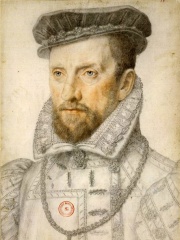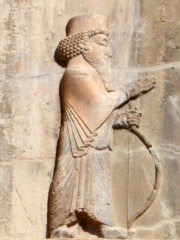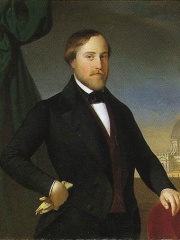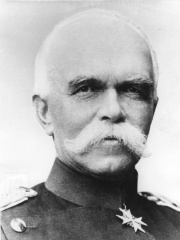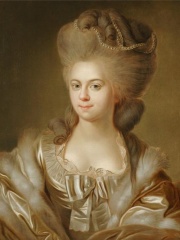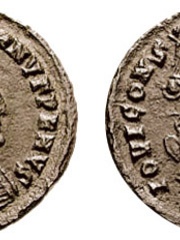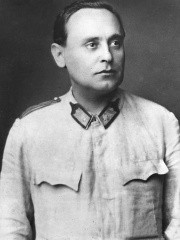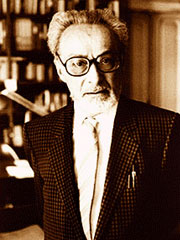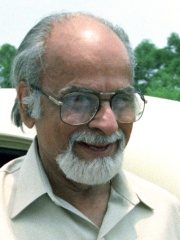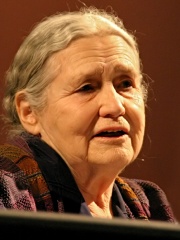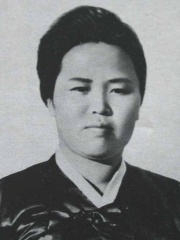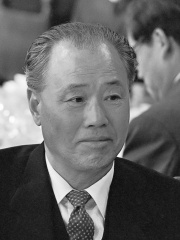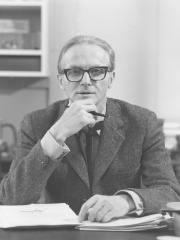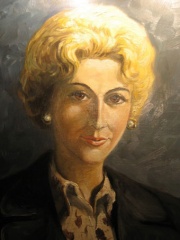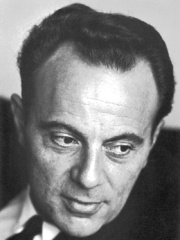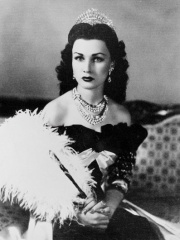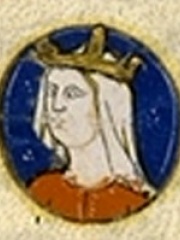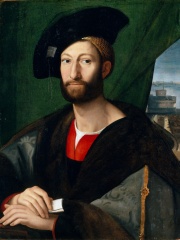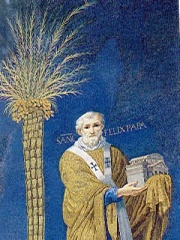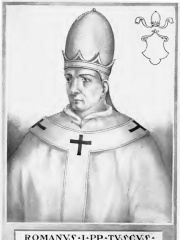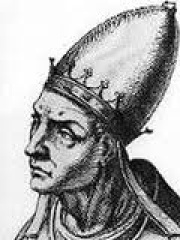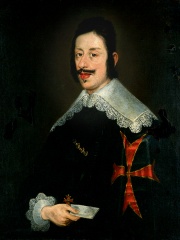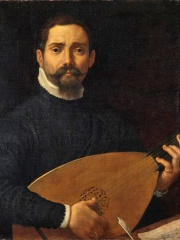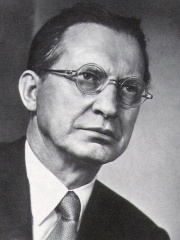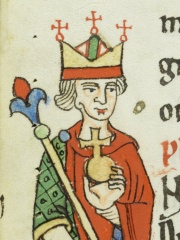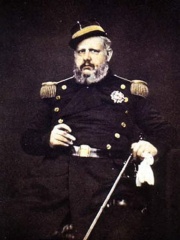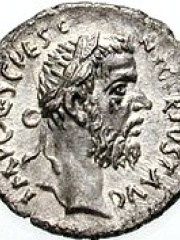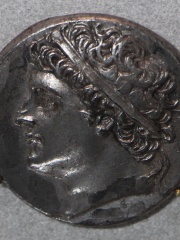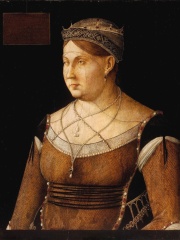POLITICIAN
Giulio Andreotti
1919 - 2013

 Giulio Andreotti
Giulio Andreotti
Giulio Andreotti (US: AHN-dray-OT-ee; Italian: [ˈdʒuːljo andreˈɔtti]; 14 January 1919 – 6 May 2013) was an Italian politician and statesman who served as the 41st prime minister of Italy in seven governments (1972–1973, 1976–1979, and 1989–1992), and was leader of the Christian Democracy party and its right-wing; he was the sixth-longest-serving prime minister since the Italian unification and the second-longest-serving post-war prime minister. Andreotti is widely considered the most powerful and prominent politician of the First Republic. Beginning as a protégé of Alcide De Gasperi, Andreotti achieved cabinet rank at a young age and occupied all the major offices of the state over the course of a 40-year political career, being seen as a reassuring figure by the civil service, the business community, and the Vatican. Read more on Wikipedia
His biography is available in 75 different languages on Wikipedia (up from 74 in 2024). Giulio Andreotti is the 1,721st most popular politician (down from 1,350th in 2024), the 647th most popular biography from Italy (down from 538th in 2019) and the 114th most popular Italian Politician.
Giulio Andreotti was a Christian Democrat who served as Prime Minister of Italy seven times. He is most famous for being the longest-serving prime minister of Italy.
Memorability Metrics
Page views of Giulio Andreotti by language
Among POLITICIANS
Among politicians, Giulio Andreotti ranks 1,721 out of 19,576. Before him are Han Duck-soo, Léon Degrelle, Gaspard II de Coligny, Artaxerxes III, Rafael Trujillo, and Henri, Count of Chambord. After him are Leo von Caprivi, Queen Paola of Belgium, Tim Walz, Duchess Elisabeth of Württemberg, Martinian, and Ferenc Szálasi.
Most Popular Politicians in Wikipedia
Go to all RankingsHan Duck-soo
1949 - Present
HPI: 73.11
Rank: 1,716
Léon Degrelle
1906 - 1994
HPI: 73.11
Rank: 1,717
Gaspard II de Coligny
1519 - 1572
HPI: 73.11
Rank: 1,718
Artaxerxes III
425 BC - 338 BC
HPI: 73.10
Rank: 1,719
Rafael Trujillo
1891 - 1961
HPI: 73.10
Rank: 1,720
Henri, Count of Chambord
1820 - 1883
HPI: 73.09
Rank: 1,721
Giulio Andreotti
1919 - 2013
HPI: 73.09
Rank: 1,722
Leo von Caprivi
1831 - 1899
HPI: 73.09
Rank: 1,723
Queen Paola of Belgium
1937 - Present
HPI: 73.09
Rank: 1,724
Tim Walz
1964 - Present
HPI: 73.09
Rank: 1,725
Duchess Elisabeth of Württemberg
1767 - 1790
HPI: 73.09
Rank: 1,726
Martinian
250 - 324
HPI: 73.09
Rank: 1,727
Ferenc Szálasi
1897 - 1946
HPI: 73.08
Rank: 1,728
Contemporaries
Among people born in 1919, Giulio Andreotti ranks 13. Before him are Primo Levi, I. K. Gujral, Doris Lessing, Kim Jong-suk, Joseph Murray, and G. E. M. Anscombe. After him are Choi Kyu-hah, Zhao Ziyang, Moïse Tshombe, William Lipscomb, Desmond Doss, and Matilde Camus. Among people deceased in 2013, Giulio Andreotti ranks 20. Before him are Mohammed Omar, Peter O'Toole, Christian de Duve, J. J. Cale, Giuliano Gemma, and François Jacob. After him are Paul Walker, Douglas Engelbart, Djalma Santos, James Avery, Fawzia Fuad of Egypt, and Boris Berezovsky.
Others Born in 1919
Go to all RankingsPrimo Levi
WRITER
1919 - 1987
HPI: 76.62
Rank: 7
I. K. Gujral
POLITICIAN
1919 - 2012
HPI: 75.79
Rank: 8
Doris Lessing
WRITER
1919 - 2013
HPI: 75.37
Rank: 9
Kim Jong-suk
POLITICIAN
1919 - 1949
HPI: 74.46
Rank: 10
Joseph Murray
PHYSICIAN
1919 - 2012
HPI: 74.20
Rank: 11
G. E. M. Anscombe
PHILOSOPHER
1919 - 2001
HPI: 73.41
Rank: 12
Giulio Andreotti
POLITICIAN
1919 - 2013
HPI: 73.09
Rank: 13
Choi Kyu-hah
POLITICIAN
1919 - 2006
HPI: 72.98
Rank: 14
Zhao Ziyang
POLITICIAN
1919 - 2005
HPI: 72.96
Rank: 15
Moïse Tshombe
POLITICIAN
1919 - 1969
HPI: 72.77
Rank: 16
William Lipscomb
CHEMIST
1919 - 2011
HPI: 72.47
Rank: 17
Desmond Doss
MILITARY PERSONNEL
1919 - 2006
HPI: 72.42
Rank: 18
Matilde Camus
WRITER
1919 - 2012
HPI: 72.09
Rank: 19
Others Deceased in 2013
Go to all RankingsMohammed Omar
POLITICIAN
1962 - 2013
HPI: 74.34
Rank: 14
Peter O'Toole
ACTOR
1932 - 2013
HPI: 74.28
Rank: 15
Christian de Duve
BIOLOGIST
1917 - 2013
HPI: 74.14
Rank: 16
J. J. Cale
MUSICIAN
1938 - 2013
HPI: 74.00
Rank: 17
Giuliano Gemma
ACTOR
1938 - 2013
HPI: 73.52
Rank: 18
François Jacob
BIOLOGIST
1920 - 2013
HPI: 73.09
Rank: 19
Giulio Andreotti
POLITICIAN
1919 - 2013
HPI: 73.09
Rank: 20
Paul Walker
ACTOR
1973 - 2013
HPI: 72.71
Rank: 21
Douglas Engelbart
INVENTOR
1925 - 2013
HPI: 72.65
Rank: 22
Djalma Santos
SOCCER PLAYER
1929 - 2013
HPI: 72.48
Rank: 23
James Avery
ACTOR
1945 - 2013
HPI: 72.34
Rank: 24
Fawzia Fuad of Egypt
COMPANION
1921 - 2013
HPI: 72.31
Rank: 25
Boris Berezovsky
BUSINESSPERSON
1946 - 2013
HPI: 72.25
Rank: 26
In Italy
Among people born in Italy, Giulio Andreotti ranks 647 out of 5,161. Before him are Isabella of Aragon, Queen of France (1248), Umberto Boccioni (1882), Giuliano de' Medici, Duke of Nemours (1479), Pope Felix IV (480), Pope Romanus (850), and Ludovico Einaudi (1955). After him are Queen Paola of Belgium (1937), Pope Leo VIII (900), Ferdinando II de' Medici, Grand Duke of Tuscany (1610), Franco Nero (1941), Giovanni Gabrieli (1557), and Alcide De Gasperi (1881).
Others born in Italy
Go to all RankingsIsabella of Aragon, Queen of France
POLITICIAN
1248 - 1271
HPI: 73.14
Rank: 641
Umberto Boccioni
PAINTER
1882 - 1916
HPI: 73.13
Rank: 642
Giuliano de' Medici, Duke of Nemours
POLITICIAN
1479 - 1516
HPI: 73.12
Rank: 643
Pope Felix IV
RELIGIOUS FIGURE
480 - 530
HPI: 73.11
Rank: 644
Pope Romanus
RELIGIOUS FIGURE
850 - 897
HPI: 73.11
Rank: 645
Ludovico Einaudi
MUSICIAN
1955 - Present
HPI: 73.11
Rank: 646
Giulio Andreotti
POLITICIAN
1919 - 2013
HPI: 73.09
Rank: 647
Queen Paola of Belgium
POLITICIAN
1937 - Present
HPI: 73.09
Rank: 648
Pope Leo VIII
RELIGIOUS FIGURE
900 - 965
HPI: 73.09
Rank: 649
Ferdinando II de' Medici, Grand Duke of Tuscany
POLITICIAN
1610 - 1670
HPI: 73.04
Rank: 650
Franco Nero
ACTOR
1941 - Present
HPI: 73.03
Rank: 651
Giovanni Gabrieli
COMPOSER
1557 - 1612
HPI: 73.03
Rank: 652
Alcide De Gasperi
POLITICIAN
1881 - 1954
HPI: 73.02
Rank: 653
Among POLITICIANS In Italy
Among politicians born in Italy, Giulio Andreotti ranks 114. Before him are Philip of Swabia (1177), Ferdinand II of the Two Sicilies (1810), Pupienus (170), Pescennius Niger (135), Isabella of Aragon, Queen of France (1248), and Giuliano de' Medici, Duke of Nemours (1479). After him are Queen Paola of Belgium (1937), Ferdinando II de' Medici, Grand Duke of Tuscany (1610), Alcide De Gasperi (1881), Hiero II of Syracuse (-308), Giorgia Meloni (1977), and Catherine Cornaro (1454).
Philip of Swabia
1177 - 1208
HPI: 73.27
Rank: 108
Ferdinand II of the Two Sicilies
1810 - 1859
HPI: 73.22
Rank: 109
Pupienus
170 - 238
HPI: 73.21
Rank: 110
Pescennius Niger
135 - 194
HPI: 73.20
Rank: 111
Isabella of Aragon, Queen of France
1248 - 1271
HPI: 73.14
Rank: 112
Giuliano de' Medici, Duke of Nemours
1479 - 1516
HPI: 73.12
Rank: 113
Giulio Andreotti
1919 - 2013
HPI: 73.09
Rank: 114
Queen Paola of Belgium
1937 - Present
HPI: 73.09
Rank: 115
Ferdinando II de' Medici, Grand Duke of Tuscany
1610 - 1670
HPI: 73.04
Rank: 116
Alcide De Gasperi
1881 - 1954
HPI: 73.02
Rank: 117
Hiero II of Syracuse
308 BC - 215 BC
HPI: 73.00
Rank: 118
Giorgia Meloni
1977 - Present
HPI: 72.99
Rank: 119
Catherine Cornaro
1454 - 1510
HPI: 72.97
Rank: 120


